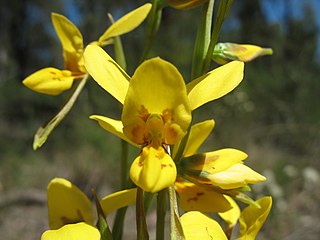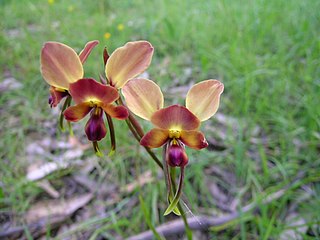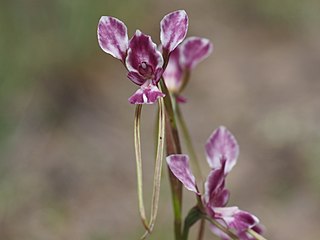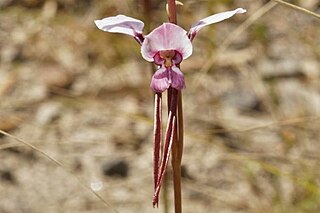
Diuris aurea, commonly known as the golden donkey orchid, is a species of orchid which is endemic to Australia, growing in New South Wales and Queensland. It has one or two leaves at the base and two to five golden-yellow to orange flowers with some darker markings.

Diuris orientis, commonly called the wallflower orchid or eastern wallflower orchid, is a species of orchid which is endemic to eastern Australia. Like others in the genus Diuris, it has two ear-like petals and is similar to the common donkey orchid of Western Australia with which it has been confused. This species is found in New South Wales, Victoria, South Australia and Tasmania and its stalk-like petal "claw" is shorter in than those of D. corymbosa.

Diuris alba, commonly called the white donkey orchid, is a species of orchid which is endemic to eastern Australia. It has up to three leaves, and a flowering stem with up to seven white flowers with purplish markings.

Diuris abbreviata, commonly known as the lemon doubletail, is a species of orchid that is endemic to eastern Australia. It has two or three leaves and a flowering stem with up to nine yellow flowers with darker markings.

Diuris eborensis is a species of orchid which is endemic to eastern Australia. It has up to six grass-like leaves and a flowering stem with up to four pale yellowish flowers with dark reddish purple streaks.

Diuris dendrobioides, commonly known as the wedge diuris, is a species of orchid which is endemic to eastern Australia. It has one or two leaves and a flowering stem with up to six pale lilac-coloured to mauve flowers with darker markings.
Genoplesium alticola, commonly known as the tableland midge orchid, is a small terrestrial orchid endemic to Queensland. It has a single thin leaf fused to the flowering stem and up to twenty five small, hairy, dark purplish-red and green flowers. It grows in two small areas of the state at altitudes between 600 and 750 m.

Diuris magnifica, commonly called the large pansy orchid is a species of orchid which is endemic to the south-west of Western Australia. It has large, colourful flowers and is common in a narrow range near the coast around Perth, often occurring with the similar but smaller Diuris corymbosa.

Diuris punctata, commonly known as the purple donkey orchid is a species of orchid which is endemic to south-eastern continental Australia. It has two grass-like leaves and up to ten purple or mauve flowers, often with darker, sometimes yellow marks. A yellow form from near Guyra is probably now extinct.
Diuris amplissima, commonly called the giant donkey orchid is a species of orchid that is endemic to the south-west of Western Australia. It is a rare species and the largest Diuris in Western Australia. It has two or three leaves at its base and up to seven purple and dull yellowish-brown flowers on a tall flowering stem.

Diuris arenaria, commonly known as the Tomaree donkey orchid or sand doubletail is a species of orchid which is endemic to a very small area of New South Wales. It has two grass-like leaves and up to nine mauve or light purple and white flowers. It has a very limited distribution near Newcastle.

Diuris chrysantha, commonly known as granite donkey orchid, is a species of orchid that is endemic to eastern Australia. It has one or two leaves and up to seven deep golden to orange-coloured flowers with brown markings and occurs on the ranges and tablelands north from Tamworth to the Darling Downs.

Diuris concinna, commonly called the elegant donkey orchid, is a species of orchid which is endemic to the south-west of Western Australia. It has up to five linear leaves at its base and up to five pale yellow flowers with brown markings. It is found along the south coast, often growing in areas that are flooded in winter and flowering more prolifically after fire the previous summer.
Diuris eburnea is a species of orchid that is endemic to the south-west of Western Australia. It has between four and six linear leaves and up to eight pale yellow to cream-coloured flowers with reddish markings. It is only known from near the Arrowsmith River north of Eneabba.
Diuris exitela, commonly called the Mount Moffat doubletail, is a species of orchid which is endemic to central western Queensland. It has two linear leaves at its base, up to twelve bright yellow flowers with dark brown markings and grows on sandstone cliffs and ridges.
Diuris heberlei, commonly called Heberle's donkey orchid, is a species of orchid which is endemic to the south-west of Western Australia. It has three to five linear leaves at its base and up to four bright yellow flowers with a reddish brown border around the labellum callus. It is found along the south coast and is one of the last Diuris to flower in Western Australia.
Diuris luteola, commonly called the northern doubletail, is a species of orchid which is endemic to Queensland. It has a single linear leaf at its base and up to six pale yellow flowers with a few brown markings. It grows in shallow, stony soil on tablelands in eastern parts of the state.
Diuris parvipetala, commonly known as slender purple donkey orchid, is a species of orchid that is endemic to eastern Australia. It usually has two leaves at its base and up to nine relatively small, whitish to mauve flowers with purple markings. It is an uncommon species found in northern New South Wales and southern Queensland.

Diuris pulchella, commonly called the beautiful donkey orchid is a species of orchid that is endemic to the south-eastern part of the south-west of Western Australia. It has two or three leaves at its base and up to five bright yellow and mauve flowers described as "exquisite", "spectacular" and "attractive". It grows in shallow soil on granite outcrops near Esperance.
Diuris unica is a species of orchid which is endemic to eastern Australia. It usually has only one grass-like leaf at its base and up to eight bright, lemon-yellow flowers with a few dark markings. It is similar to D. chrysantha but flowers much earlier than that species and has only a single leaf rather than two.












